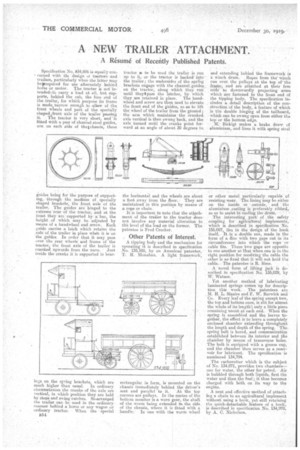A NEW TRAILER ATTACHMENT
Page 26

If you've noticed an error in this article please click here to report it so we can fix it.
A Résumé of Recently Published Patents.
Specification No. 134,956 is equally concerned with du .design of treeters • and • trailers, particularly when the latter may beirequired for use alternately behind horse or motor. The tractor is not intended, to carry a eload at all, but sup, ports, behind the cab, the fore end of the 'trailer, for which purpose its frame is Made ...narrow enough to allow of the front ivheels and part of the specially shapeclifront axle of the trailer passing
it. The tractor is very short, and is fitted with a pair of channel steel guides, • one on each side of theechassis, these
guides being for the purpose of supportmg, through the medium of specially shaped brackets; the front axle of the trailer. The guides are hinged to the extreme rear of the tractor, and at the front they 'are supported by a, bar, the height . of which may be. adjusted by means of a handwheel and screw. Each guide carries a latch which retains the axle'of the trailer lit place when it is on the guides. In order that it may pass over the rear wheels' and frame of the tractor,the front axle of the trailer is cranked upwards from the nave. Just inside the cranks it is supported in bear
hies on the spring brackets, which are nu ch higher than usual. In ordinary circumstances the cranks of the axle are ve ilea', in which position they are held by stops and swing catches. So-arranged the trailer canbe used in the. ordinary manner behind a horse or any wagon or ordinary tractor When: the 'special 354
tractor AS to be used the trailer is rim up to it, or the tractor is backed into the trailer; the underaides of the spring brackets engage with the channel guides on the tractor, along which they run. until theyepa.ss the latches, by which they are retained in place. The handwheel and screw are then used to elevate the front end of the guides, so as to lift the wheel of the trailer from the ground ; the arm which maintains • the cranked. axle vertical is then swung, back, and the axle turned until the cranks point forward at an angle of about 30 degrees to.
the horizontal and the wheels are about a foot away from the floor. They are maintained in this position by means of rope or chain. i It s important to note that the attachment of the trailer to the tractor does not involve any material alteration to the level of the load on the former. The patentee is Fred Crocker.
, Other Patents of Interest.
A tipping body and the mechanism for operating it is described in specification No, 135,108, by an American patentee, T. H. Monahan. A light framework, rectangular in form, is mounted on the chassis immediately behind the driver's seat and parallel to it. At the top .corners are pulleys. In the centre of the bottom member is a worn gear, the shaft of the worm being extended eis the side of the clisssis, where it is fitted with a handle': In one with the worm wheel and extending behind the framework is a winch drum. Ropes from the' winch run over the pulleys at the top of the frame, and are attached at their free ends to downwardly projecting arms which are fastened to the front end of the tipping body. The specification includes a detail description of the construction 'of the body, a feature of which is the double hinging of the tailboard, whigh can be swung open from either the top or the bottom edge. M: Birkigt makes a brake drier of aluminium, and lines it with spring steel or other metal particularly capable' of resisting wear. The lining may be either on the inside or • outside, and the aluminium casting is preferably ribbed, so as to assist in cooling the drum.
The interesting. part of the safety coupling for agricultural implements, which is described in spcification No, 135,097, lies in the design of the bOok itself. It is a double one, made in the form of a disc with two gaps cut in its circumference into which the rope or cable fits. These two gaps are opposite to one another so that when one is in the right position for receiving the cable the other is so fixed that it will not hold the cable.. The patentee ball. Sime.
A novel form of lifting jack is described in .specification No. 135,029, by W. Watson.
Yet another method of lubricating laminated springs comes up for description this week. The patentees are M. H. L. Sizaire and F. W. Berwick and Co. Every leaf of the spring except two, the top and bottom ones, is slit for almost the whole of its length'; only a little piece remaining uncut at each end. When the spring is assembled and the leaves together, the effect is to leave a completely enclosed chamber extending throughout the length and depth of the spring. • The. spring bolt is bored, and communication established between its interior and the chamber by means of transverse holes. The bolt is equipped with a grease cup, and the chamber then serves as a reservoir for lubricant. The specification • is numbered 134,794.
The carburetter which is the subject of No. 134,871, provides two chambers—. one for water, the other for petrol. Air is bubbled through both liquids, first the water and then the fuel; it thus becomes charged with bah on its way to the engine.
A neat and effective method of attaching a chain to an agricultural implement without' using a hook, yet still retaining the .quick-detachable feature of a hook', is described in specification No. 134,978, by A. C. Nicholson,


























